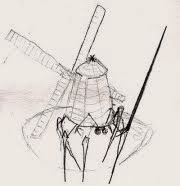Until recently* my primary oscilloscope was a old Leader 515, which had been well-loved in its former role as a tackling dummy at a local technical college. I'm not complaining; it did what I asked it, so long as I only used simple sentence structure and raised my voice. It was kind of like having a very old and decrepit servant, one that any given moment was trembling along the ragged edge of dementia.
And this was my good 'scope.
The other one was a green single channel monster with vacuum tubes and thumbscrew terminals for the probe attachments. Care to guess its bandwidth? No need to bother - it was low, low low, baby. Good for a audio signal wigglescope display**, most of the time. If it was a servant, than it would be the shaking and snail like butler out of Sherlock Holmes:A Game of Shadows.
EDIT: Its a Starkit, and not very Googleable.I think I might need to post a write-up.
Needless to say, I used it largely as a paperweight. Being landlocked, I have little need for boat anchors, and anyways, a boat anchor is capable of actually serving a useful purpose.
While tinkering with the Rigol, I needed a signal, so I thought I'd measure the calibration wave on the Leader. It was, I supposed, a 1kHz, 0.5v p-p square wave.
Nope.
The wave was pretty square, even when the Rigol was turned up to full resolution, but the little frequency counter display claimed 980.4 Hz.
So could the Leader have drifted that far in its senescence? Or was it always 980Hz, in which case, why?
I can't imagine the Rigol being that inaccurate right out of the box, especially not a digital scope.
*A combination of a birthday, Rigol, and the most awesome wife in existence.
**The only device I have ever used that managed to fray its AC cord at the (very inadequate) strain-relief entry, and arc flash to the case one day when plugged in. Two prong plug, of course.
skip to main |
skip to sidebar
About Me
Blog Archive
-
▼
2014
(64)
-
▼
January
(20)
- Fore-shadowing
- Complaint Department
- "Your 'Right' or my 'Right'"
- Colonel 'Sierpinski' Korn
- Dho-Na Curve of the Sleeper
- O RLY?
- Is this 'Prolapse' or 'Inversion'?
- Gender Bender InterChangers
- Another taste of the Mandible
- "Now cruising in his Pinto..."
- 'Rod Logic' - I feel like I've accidentally wander...
- Raptor Crampons
- By the Hand of Saint Markov
- "...I'm dying with sleep"
- Not 1kHz
- Aphoritaxic: Do not grasp your own wit by the blade.
- Satan's Calliope
- Questions for the New Year
- Track Of The (Werewolf) Moon Beast
- Tumblr's War on Context
-
▼
January
(20)


No comments:
Post a Comment